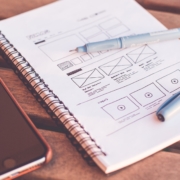How Long It Really Takes To Build A Good Website
It’s time to take your website idea to the next level. You’ve done the research, looked at your competitors, and pieced together all the content you need. The next step is web development. So how long will it take to launch your new website, and when it launches, will it instantly be updated in search engines?
Building a website can vary widely depending on how much front-end and back-end development you need. Customization and complex content can slow down a launch, but it can also improve your user experience and lead to more conversions.
Whether you want to build a new website or update your current web design, launching a website takes time. While there are website builders out there that claim you can build a website in an hour, template designs don’t help your business stand out from a crowd or easily get your user into a checkout. These goals require customization, conversion rate optimization and smart website development.
While building a good website won’t take just a couple hours, it doesn’t have to take a year either. Our expert web development team provides some insight into the process and the necessary time frames to build the best websites for our clients.
A Look at How Website Development Works
No two websites are the same unless they were duplicated, but why would you copy a competitor’s design? Even when using a template, every business wants their website to be different. This is why customization and unique development are key to a successful website.
There are no blanket time frames for building a website, however, if you have the content and graphics ready, it can cut the time to launch in half.
Here is a look at how a website design agency takes an idea from design to development to launch:
- After site discovery and asset collection, a launch plan is created and shared with the client, listing the strategy, goals, and milestones of the development project
- All branding, style guidelines, previous designs and new ideas are presented to the web design team
- The design team creates a few wireframes or mockups to share with the client
- Once the wireframe is approved, the project is shared with the web development team
- Designers and developers work together to create the basic front-end, while back-end development gets started
- Depending on the amount of content and pages, 1 to 2 weeks of development are needed for a custom design, but larger sites requiring more integrations or complex back-end development will likely need additional time
- Clients receive a demo of the website to review and final edits are made until the website is approved for launch
Everything must be perfect before your website launches. One caveat for website development time is the number of assets provided and customized code. This is why it’s so important to get a launch plan ahead of the project that details every step and provides an estimated time to launch.
Understanding The Stages Of Website Development
Perhaps you want to build a website in a week and think it can be done using a website builder. Even when you decide to build it on your own, who will create the graphics, copy, animated elements, forms, product catalog, checkout and other necessary pieces to make your website run correctly?
Take a second to look at how long it can truly take to develop a well-designed website that will attract new customers and entice existing ones to visit.
1. Discovery Stage: 1 to 3 weeks
Lasting between 1 and 3 weeks, the discovery stage is the most important part of building a website. Without properly identifying the goals of a website and reviewing branding assets, your website won’t have a clear direction, which could lead to improper user experience or bland design.
However, a good discovery process results in a clear plan of action with everything the design and development team needs to build the perfect website.
2. Design Stage: 3 to 6 weeks
Web designers bring it all together, using the assets and information provided about the project. Assets typically include:
- Branding, logos, and style guides
- Previous design and markup for improvements (if rebranding/rebuilding)
- Sample of messaging
- Color palette
- Custom page layouts needed (Home page, About us, Contact us, Service pages, etc)
Using this information, a wireframe mockup is created for the whole website, including all major pages and samples of landing pages that the client wants to include. These files may be shared as PDFs or integrated into an animated, interactive wireframe through an app like Invision.
Once the wireframes are approved, they go to the next stage.
3. Development Stage: 1 to 4 weeks
Depending on the amount of customization and back-end development needed, coding may take longer. Developers work side-by-side with designers for the first week, getting the basic development just right so that it matches the design.
In the next few weeks, a demo site is built in a private staging environment. Developers build out each page according to the design files, customizing elements so that they work flawlessly.
4. Final Revision Stage: 1 to 2 weeks
Once finished, the demo site is shared with the client and the next round of revisions begin until the development is finalized and approved for launch. This is when clients work with developers to make changes. This process takes longer if new features are requested that were not in the original design.
5. Quality Assurance Check Stage: 1 week
Before launching, all sites must pass a QA check. The site is tested in various browsers and on multiple devices, looking for any signs of bugs and issues. In addition, the user experience is checked for optimal conversion rates.
Once the QA check is complete and the site is ready, your website is finally ready for launch.
6. Launch Stage: Less than a week
After all this time, the launch stage is fairly quick. Once everything is in place and approved you need to ensure that all of the additional, miscellaneous items are in order. This can include a variety of things, including:
- Creating a Google Analytics account for the site
- Setting up conversion tracking
- Setting up 301 redirects
- Auditing for errors that occurred during the launch
It cannot be stressed enough how important this last part of the stage is. You’ve spent so much time getting your site built; it’s mandatory that everything is set up right so you can have a truly successful launch.
Next Steps: How will you market your new website?
Now that the newly created or redesigned website is up and running, it’s time to start considering additional aspects of your business. Finding new ways to drive sales should be your number one priority now that you’ve invested so much time and money into your site.
There are numerous ways to reach out and advertise your new site and business to an audience. From retargeting users to setting up paid social media campaigns, there are many avenues that you can go down to generate #success.
Looking For A Website Development Agency?
A new website could help your business, so why wait? We want to create the perfect website for your company, and it may not take as long as you think. We’ll provide you with the perfect website design while you work side-by-side with our full-stack development team.
Let’s talk about your website idea today.











